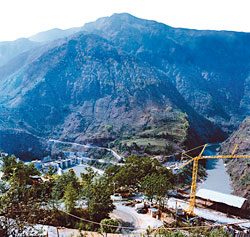 The ongoing bloody insurgency might have been avoided ten years ago if someone could have given Prachanda and Baburam a pocket calculator and a map.
The ongoing bloody insurgency might have been avoided ten years ago if someone could have given Prachanda and Baburam a pocket calculator and a map.
Here's some number crunching. The surface area of Nepal is 140,800 km2. Arable land covers 16.07 percent which is 22,627 km2. The population of Nepal is 28,287,147 (July 2006 estimate). Eighty five percent of the population is rural, which is a little over 24 million.
If there was a reform program sharing the arable land equally the result would be that each man, woman, or child would receive a plot of land 24 m x 40 m. That's slightly less than one tenth of a hectare. It is perhaps enough to raise a goat on but insufficient by far to provide a decent standard of living for a human being.
There actually isn't any land to redistribute in Nepal. The myth of agrarian utopia is being propagated by ruthless counter-elites who are influenced by an outdated Marxist ideology and exploiting the myth to further their own political ambitions rather than furthering the commonwealth of the people.
The real problem in Nepal is that over the past 50 years, well-meaning and morally justifiable health care programs have cut infant mortality, while educational expansion has created greater literacy and demand for employment. Yet Nepal's population has grown faster than its economy. Infrastructure and social services development have not kept pace.
Nepal has passed its carrying capacity as an agrarian society. There is only one practical solution: it must have a realistic plan to change from 85 percent rural to 85 urban over the next 20 years. Nepal must industrialise and urbanise-and create the infrastructure for modern city states where dynamic shifts in culture, education and technology can take place.
How is Nepal going to find the hundreds of millions, if not billions, of dollars necessary to achieve this goal? Currently, the only known resource for doing this is Nepal's huge undeveloped hydropower potential. A common national goal accepted by all would undermine the apparent support for the insurgency.
Theoretically it is technically and economically feasible to develop about 43,000 MW of hydropower. All of Nepal could be electrified with up to 5,000 MW. The remaining power would be equivalent to putting a 25 Watt light bulb in every house on Planet Earth and there would still be power left over. The market is just next door. Right now the adjacent States of India have a short-fall of 20,000 MW. Within the next 10 years India will need an additional 100,000 MW of installed capacity to grow economically. Nepal is a key player for solving India's energy problem.
The Snowy Mountains Engineering Company (SMEC), have been negotiating power sales with the Power Trading Corporation (PTC) India Ltd for the 750 MW West Seti hydropower project. When this project is online the annual royalties alone would be about $ 20 million. Of this money the Local Self-Governance Regulation stipulates that 10 percent would go to Doti DDC.
There is not a fixed amount of wealth in the world that needs to be redistributed. Developing hydropower in Nepal would create wealth. This would not only benefit Nepal but the rest of the economies of South Asia.
Harnessing Nepal's hydroelectric potential will be capital intensive and will require massive investment up front from foreign governments, multilateral organisation and private businessmen. Such investment will not be possible unless Nepal is politically stable, security can be provided in the countryside, and the government is favourable to investors.
An atmosphere for transformative investment will not be possible while Nepal is suffering an insurgency being led by extortionate would-be revolutionaries who oppose private capitalism and foreign business.
Dr Steve Gorzula worked in the Department of Electricity Development from 1998-2004 for USAID's Private Sector Hydropower Development Project.



